Anywhere But Here
PAST EVENTS
Tuesday, September 13, 2016, 6-9pm
Opening of the Anywhere But Here exhibition
With curators (Mélanie Mermod and Vera Mey) and artists Vuth Lyno, Tran Minh Duc and Albert Samreth.
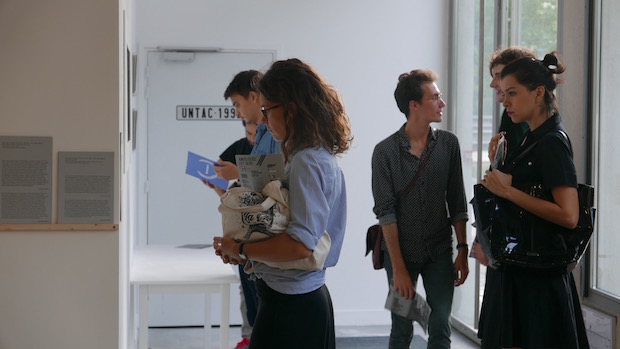
- Opening of the exhibition "Anywhere But Here" – Bétonsalon - Center for Art and Research, Paris, 2016. Vuth Lyno, UNTAC Project, 2016. Courtesy of the artist.

- Opening of the exhibition "Anywhere But Here" – Bétonsalon - Center for Art and Research, Paris, 2016. Courtesy of Koh Nguang How.
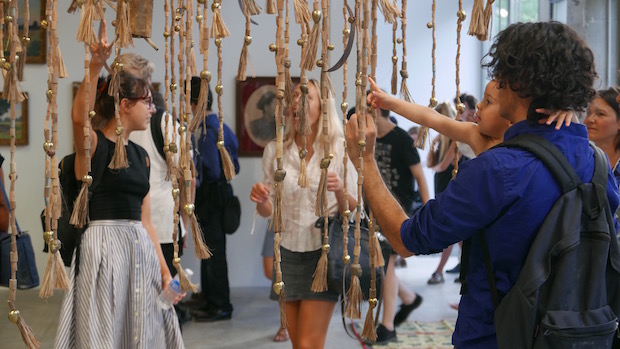
- Opening of the exhibition "Anywhere But Here" – Bétonsalon - Center for Art and Research, Paris, 2016. Thao-Nguyen Phan, Heads from Uproot Rice, Grow Jute series, 2014. Courtesy of the artist.
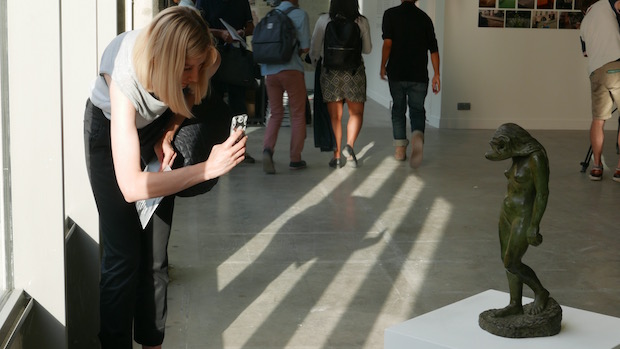
- Opening of the exhibition "Anywhere But Here" – Bétonsalon - Center for Art and Research, Paris, 2016. Hàm Nghi (Tu Xuân), Femme à la coloquinte, 1925. Private collection, Paris.
Wednesday, September 14, 2016, 2:45pm
The Awaking Ceremony of Catha
For Anywhere But Here, artist Khvav Samnang (1982, Svay Rieng, Cambodia) is working on a new project evoking the use of the yantras by the Cambodian diaspora settled in Paris over the time. For the duration of the exhibition, members of the community are lending different kinds of objects ornamented with geometrical patterns. In the course of the Awaking Ceremony these adornments will be “replenished” by a monk.
These objects are encircled with a cotton belt (Catha) that looks just like the waistbands worn by Cambodian soldiers sent to France during Word War One. The cotton strap was meant to provide protection to whomever or whatever it girded.

- The Awaking Ceremony of Catha – in the framework of Anywhere But Here, Bétonsalon - Center for Art and Research, Paris, 2016.
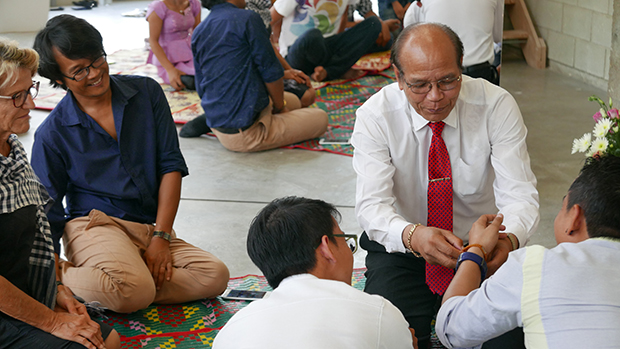
- The Awaking Ceremony of Catha – in the framework of Anywhere But Here, Bétonsalon - Center for Art and Research, Paris, 2016.
Saturday, September 17, 2016, 3 p.m.
Conversation: On movement
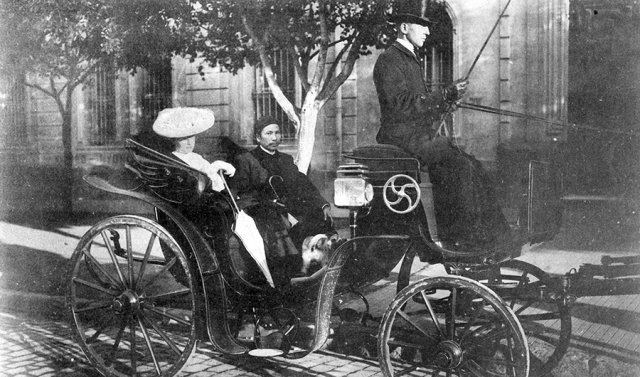
- The engagement of Emperor Hàm Nghi, 1904 – © Rights reserved
From 1862 to 1954, France has engaged with a policy of "taking possession" (or "protection order") in South-East Asia, by integrating the entirety of Cambodia, Laos and Vietnam, as well as a part of oriental China to its colonial empire. The first session of the program Anywhere But Here at Bétonsalon - Center for Art and Research aims at focusing on the movement of some individuals that were closely related to the history of the Indochinese Union. We will do so by highlighting the way in which these intimate trajectories between South-East Asia and France allow to perceive the complexity of the policies of development and preservation of the colonial regime, along with the emergence of clandestine anti-colonial movements.
Prince Canh, Nguyen Phuc Canh (1780-1801), is an emblematic figure of the relations between South-East Asia and France. As young as five years old, the young prince was sent to Versailles with a delegation in order to convince King Louis XVI to support his dynasty. This journey transformed South-East Asian political spectrum and shaped the connexions between France and Vietnam.
Speaker: Tran Minh Duc (1982, Hô-Chi-Minh-Ville, Vietnam) is a Vietnamese artist. His interest lies in the Past, its fragmentary modes of diffusion and the way it interacts with our present time. With his artistic practice, he investigates Vietnamese urban life characteristics. In order to do so, he studies the interaction between individual and collective spheres, between ideas such as the local/ internal and foreign/external. Invited by Bétonsalon – Centre for Art and Research for a residency in Paris, and in the relation to the exhibition Anywhere but Here, Tran Minh Duc will focus on the overlooked details of young prince Canh’s visit to France.
Emperor Hàm Nghi (咸宜, 1871, Huế - 1944, Alger), known as ‘The Anman Prince’ during his exile, resorted to his given name ‘Tu Xuân’ as his pseudonym. In 1885 he became the ruler of Vietnam at 13 years old only for a sole year. After being hold captive three years later, he was sent into exile in Algeria, a deed France was responsible for. In Algiers, French administration allowed him to study in fine arts with a painting teacher. This newly acquired skill would become central to his life.
Speaker : Amandine Dabat has a PhD in art history, that she has obtained at the University Paris-Sorbonne (Paris IV). Her thesis dealt with the life and the work of the Vietnamese emperor Hàm Nghi (1871-1944). Amandine Dabat also graduated in Vietnamese studies at Paris-Diderot University (Paris VII). In the course of her PhD and in relation with her studies, she travelled both in Vietman and Algeria, for two years. She has published dozen of articles and participated in various international symposiums and conferences. For two years she has been teaching at the University of Hanoi, Vietnam.
Tran Duc Thao (1917, Hanoi- 1993, Paris) was one of the greatest contemporary Marxist philosopher in Vietnam. Admitted to the École normale supérieure of the Rue d’Ulm, Paris, he passed his philosophy aggregation.
Student of Cavailles, he has been considered as one of the best specialist of phenomenology and of E. Husserl following the publication of his book Phenomenology and dialectic materialism in 1950. A leader of the Vietnamese diaspora under the German occupation in France, he returned to his country just after the outbreak of the Indochina war, where he joined the anticolonial movement that supported the national independence. Marxist critique and translator of Hegel and K.Marx in Vietnamese, he was subjected to the repression of the Communist party during the Hundred Flowers Campaign (1956-1957).
Speaker : Trinh Van Thao (1938, Sud Viêt-Nam) completed most of his higher learning in France (Sciences Po, Sorbonne). He teaches sociology and contemporary history in French Universities (Amiens, Lille, Aix Marseille, International Collège of Philosophy in Paris) and foreign universities (in Brazil, Canada, Japan….).
He is emeritus professor at AMU.
Along with the entry into war in 1939, the Indochinese administration was given the order to send more than 20 000 men from the occupied region to the metropolis. Instead of joining the French army, these men joined weapon factories. Under the supervision of the department of the ‘Main d’Oeuvre Indigène’ (or Indigenous Work Force), depending itself on the Ministry of Labour, these newly arrived men were considered as ‘non-specialised work force’. After the defeat of June 1940, these workers would be hired by different firms, for a meagre salary equivalent to one-tenth of the income of a French worker. In the region of Camargue, part of this labour force contributed to the implementation and improvement of rice fields which are still exploited nowadays.
Speaker: Journalist, former reporter of Libération, and currently reporter for Le Monde Diplomatique, Pierre Daum leads historical investigations on the colonial past of France, both in Vietnam and in Algeria. In 2009 he published Immigrés de force (Forcefully Displaced, publishing Actes Sud), unveiling the hidden history of the ’20 000’ Indochinese workers of the Second World Ward to the public at large. His book has been brought to big screen with Man Lê’s 2013 Công Binh, La Longue nuit indochinoise (The Long Indochinese Night), and to television in 2015, with Alain Lewbowicz’s Riz Amer (Bitter Rice).
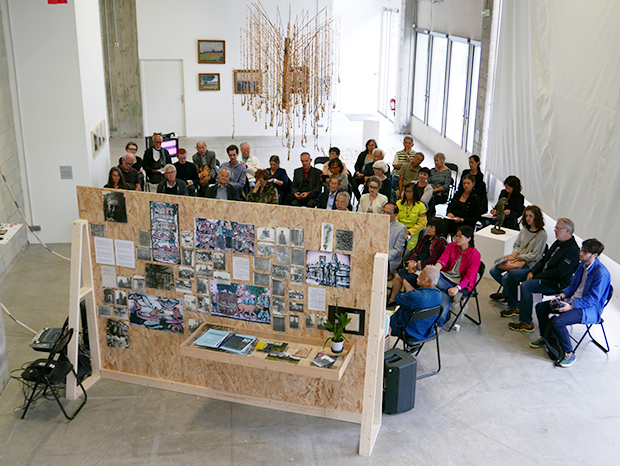
- Conversation: On movement – in the framework of Anywhere But Here, Bétonsalon - Center for Art and Research, Paris, 2016.

- Conversation: On movement – in the framework of Anywhere But Here, Bétonsalon - Center for Art and Research, Paris, 2016.
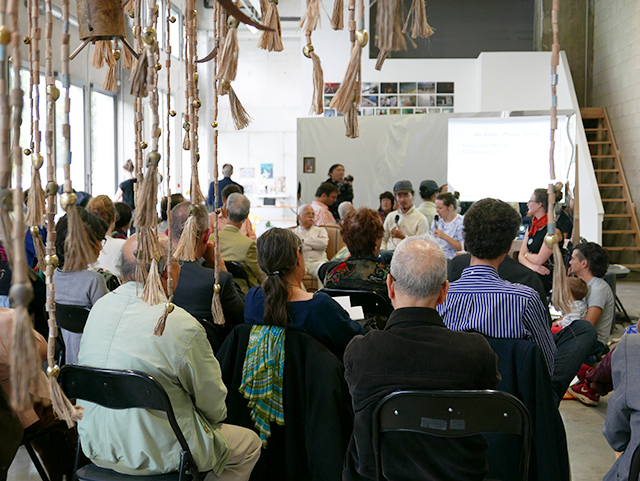
- Conversation: On movement – in the framework of Anywhere But Here, Bétonsalon - Center for Art and Research, Paris, 2016.
Tasting of the Domaine Morère coffee made at Dalal (Vietnam), thanks to the generous donation of Pierre Morère.
Tuesday, September 20, 2016 at 7:30 pm
at the Auditorium of the Cité internationale des arts
Vera Mey’s talk: Shaking & moving in South-East Asia
In the framework of Traverses.

- Sooshie Sulaiman – Chanta, 2005 - ongoing. Courtesy of the artist
Independent curator Vera Mey will draw upon a few case studies from a paper she delivered at the APT8 Conference in Brisbane about artists in Southeast Asia and their relationship to social change and artistic production. This has formed part of wider research she is conducting as co curator on SEA Project (working title), due to open in July 2017 at the Mori Art Museum and National Art Centre Tokyo in Japan.
Despite intense social change and upheaval within Southeast Asia over the recent decades, often which has resulted in a wider cultural amnesia, artists continue to show continuity between the aesthetic histories of the past and the present. Not only are artist using aesthetic devices in a continuous manner but also using history itself as a material to be constantly revised, re performed and re enacted in order to excavate dormant histories and to show continuity as a counter to forgetting. The practices of Amanda Heng, Khvay Samnang, Shooshie Sulaiman and Vuth Lyno all contain elements of performance in relation to histories which are under represented within dominant meta narratives around key moments in nation building and can be even be read as alternative histories.
The ideas of moving and shaking will be looked taking cue from the Mahabharata’s Book of the Beginning (8th– 9th Century BC) and ideas around circular time, change and overlapping histories through their practices although the respective histories are not necessarily in direct conversation. These ultimately map a history of overlapping interest and interaction through mutual historical events that impact on a social and regional scale. Even the notion of Southeast Asia as a region, more confidentally defining itself as a socio political spatial and temporal zone has had incredible change over the last fifty years.
Artists in Southeast Asia are often framed within conditions of newness and regeneration despite notions of history and continuity being ever present within the aesthetic histories of different parts of the region. Perhaps change is the only constant.
Vera Mey (Born in 1987 in Wellington, New Zealand) is an independent curator based in London. She was part of the founding team of the NTU Centre for Contemporary Art Singapore led by Ute Meta Bauer from 2013. For 2015-2016 she is guest curator at Sa Sa Bassac and Bétobsalon –Center for Art adn Research, grantee of SOAS, University of London and Getty Foundation as part of Ambitious Alignments: New Histories of Southeast Asian Art.
Wednesday September 21, from 6 p.m. to 8 p.m.
Seminar: The Apsara Transdisciplinary Research Club, session 1
A event in the framework of the Académie vivante
With Vera Mey, co-curator of the exhibition Anywhere But Here.
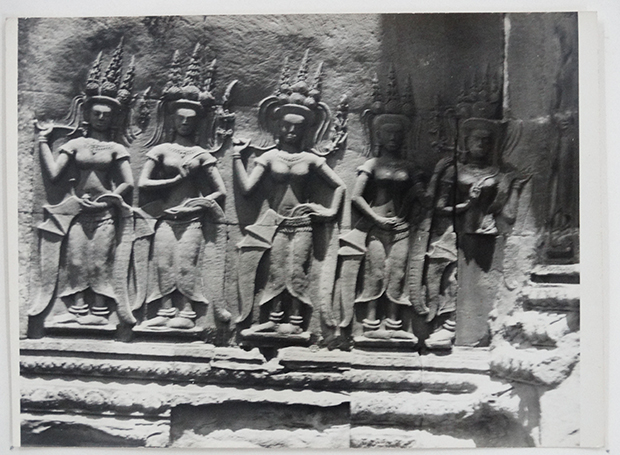
- Shu Tit Sing – photograph taken during his 1963 trip to Angkor, bas-reliefs with Apsaras. All rights reserved.
The first edition of the Apsara Transdisciplinary Research Club will look at the circulation of the figure of the Apsara and how she is circulated in wider parts of Southeast Asia and through Cambodia diaspora. The discussion will start with the Ten Men Group operative between the 1960s - 1970s and how she appeared within certain artists works from the group. The discussion will then progress to the presence of the Apsara in film clips and tourist advertising and look at the ways she is in circulation today.
Vera Mey (born in 1987 in Wellington, New Zealand) is an independent curator based in London. She was part of the founding team of the NTU Centre for Contemporary Art Singapore led by Ute Meta Bauer from 2013. For 2015-2016 she is guest curator at Sa Sa Bassac and Bétobsalon –Center for Art adn Research, grantee of SOAS, University of London and Getty Foundation as part of Ambitious Alignments: New Histories of Southeast Asian Art.
Wednesday September 28, from 6 p.m. to 8p.m.
Seminar: The Apsara Transdisciplinary Research Club, session 2
A event in the framework of the Académie vivante
With Suppya Nut, Lecturer on the South-East Asia History at the Paris-Diderot University. She will address the history and formation of the Apsara dance.
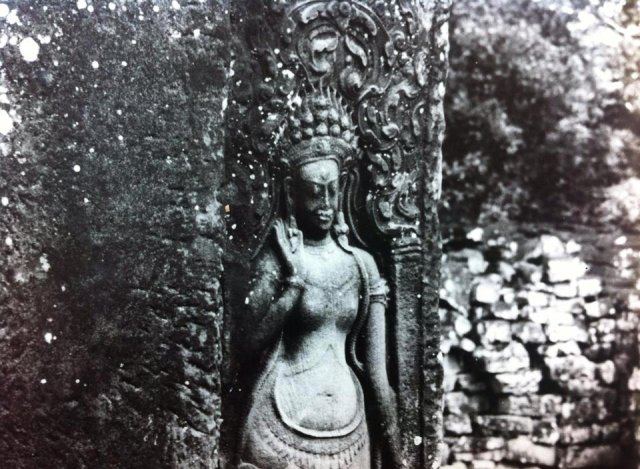
- Shu Tit Sing – photograph taken during his 1963 trip to Angkor, bas-reliefs with Apsaras. All rights reserved.
Suppya Hélène Nut is a specialist of the Royal Ballet of Cambodia. She works in collaboration with the Princess Norodom Buppha Devi, master of dance and choreography of the Royal Ballet. Suppya Nut directed the “Khmer Dance Project” on the behalf of the New-York Public Library, for which she has realized 61 videos regarding dance in Cambodia (interviews of artists, captures of dances representation). She teaches Cambodian literature and the performing arts of South-East Asia at the National Institute for Oriental Languages and Civilisations in Paris, while pursuing her research on the Royal Ballet and gender in Cambodia.
Wednesday 5 October, from 6 p.m. to 8 p.m.
Seminar: The Apsara Transdisciplinary Research Club, session 3
An event in the framework of the Académie vivante
With Jean-Pierre Couty, associate professor at Paris-Diderot University, Cochin Institute.

- Cancerous cells – all rights reserved.
Jean-Pierre Couty is immunologist, specialised in the study of the liver cancer. He is interested in deciphering the dialogue which lays at the basis of the relation between cancerous cells and those of the immune system. As a source of inspiration, part of his work is organised in way which he assumes draws similarities with street theatre, which hence could be compared to the mysteriousness of the Apsara dance. Jean-Pierre Couty simply proposes that the movement and deformation of cells (be they immune, vascular or cancerous) be further explored through the development of cancer and its evolution through time.
Thursday, October 6, 2016 from 6 to 9 pm
Tran Minh Duc’s open-studio at the Cité internationale des arts (studio 8109, 1st floor) in the framework of Traverses.
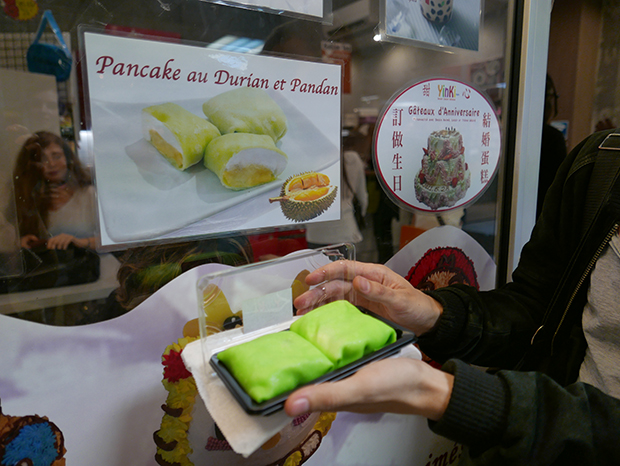
- 1st day of Tran Minh Duc’s workshop – 3D DIY modelling and artistic creation. All rights reserved.
During his open studio, Tran Minh Duc will present the on-going research that he conducts in France notably in the archive of the Paris Foreign Missions Society. The artist addresses the history of the relationship between Vietnam and France, within the destiny of the Prince Canh who at the age of seven, in 1785, was sent by his father the Emperor Gia Long (the founder of the Nguyen dynasty, the last dynasty of Vietnam) with the French Catholic Father Pigneau de Béhaine to Paris to ask for an alliance with King Louis XVI. This treaty marked the beginning of colonization of Vietnam by France. The little prince spent five years in Paris, where he took an interest in Catholicism and started to wear French clothes. When he returned to Vietnam, he couldn’t completely fit in the life and culture of his own country. The prince’s destiny symbolizes the split between time and space, between political power and borders, religious belief and freedom of belief. He inherited his Vietnamese Prince title from one the most renowned dynasty of Vietnam but ended up his life, melancholic, dwelling on his memories of the West.
For Anywhere But Here in Bétonsalon – Center for Art and Research, Tranh Minh Duc presented an artwok also linked with the Prince Canh history.
Tran Minh Duc (1982, Hô-Chi-Minh-Ville, Vietnam) is a Vietnamese artist. His interest lies in the Past, its fragmentary modes of diffusion and the way it interacts with our present time. With his artistic practice, he investigates Vietnamese urban life characteristics. In order to do so, he studies the interaction between individual and collective spheres, between ideas such as the local/ internal and foreign/external.
He was invited in Japan, Myanmar and Cambodia for residencies and participated to the following exhibitions (selection) : Global Cities, Center Stage, Baltimore, United-States, 2014 ; 15th Anniversary : Nha San Duc, Hanoi, Vietnam, 2014 ; Beyond Pressure : Festival of Performance Art, Yangon, Myanmar, 2012 ; Poetic Politic, Kadist Art Foundation, San Francisco, United-States, 2012 ; Tokyo Story, TWS Shibuya Gallery, Tokyo, Japon, 2012 ; Open Edit : AAA Mobile Library, San Art, Hô-Chi-Minh City, Vietnam, 2011.
Wednesday October 12, from 6 p.m. to 8 p.m
Seminar: The Apsara Transdisciplinary Research Club, session 4
A event in the framework of the Académie vivante
With Hélène Marquié, Lecturer at the centre for Feminine studies, Paris VIII, will talk about the intersection between gender and dance.
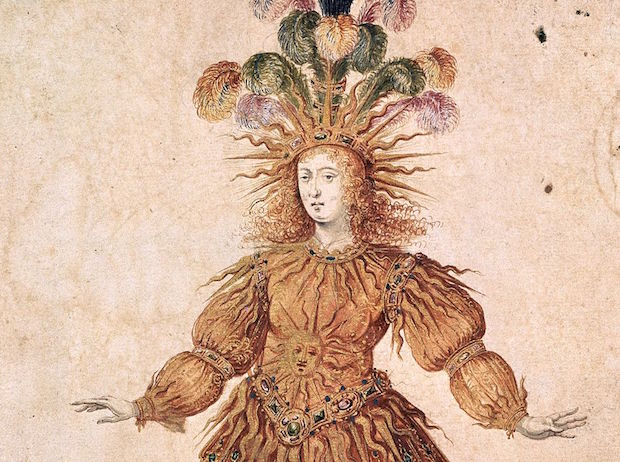
- Anonymous – Louis XIV dressed as Apollo in the Ballet of the Night, 1653, detail. All rights reserved.
During this talk, Hélène Marquié will present a part of her research localized at the intersection between dance studies and gender studies. At first she will address the way in which the perspective of the gender enlighten the anthropology of dance, what it allows us to understand about the history of the ballet in France, while establishing parallels or divergences with the khmer ballet. Finally she will focus on the different questions raised by the representations of gender and of its stereotypes.
Hélène Marquié is lecturer in gender studies at the Paris 8 University. She is a member of the LEGS (Laboratoire d’études de genre et de sexualité / Laboratory for the studies of gender and sexuality). She is also an associate professor in biology and geology. Dancer and choreographer of contemporary dance, her research is localized at the crossing between dance studies and gender studies: she addresses the history construction and representation of gender within the history of dance. She has recently published a book entitled Non, la danse n’est pas un truc de fille – Essai sur le genre en danse (or No, dance is not some girls’ stuff – Essay on gender within the field of dance, Toulouse, Éditions de l’Attribut, 2016 ).She is a member the Policy, of the Scientific and of the Management Boards of the Emilie du Châtelet Institute. For many years she has been participating in the research workshop entitled “Dance as an anthropological object”, organized by CNRS/Paris 1/EPHE/Université Blaise Pascal-Clermont-Ferrand 2 / Université de Nanterre Paris Ouest.
Saturday October 15, 5 p.m.
Tran Minh Duc’s performance When I was 6 or 7 years old in Paris with the participants of the workshop 3D DIY modelling and artistic creation.
A event in the framework of the Académie vivante
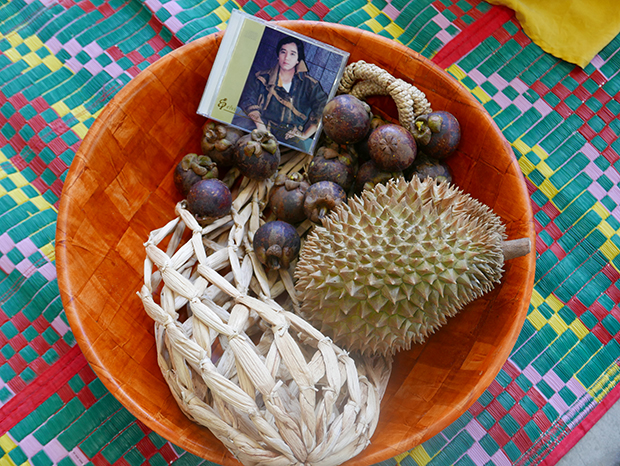
- Workshop « 3D DIY modelling and artistic creation » – in parallel to Anywhere But Here, Bétonsalon - Center for Art and Research, Paris, 2016.
During this event, Tran Minh Duc and the participants of the workshop 3D DIY modelling and artistic creation will perform the productions they made which are linked to the artist’s researches on the Prince Nguyễn Phúc Cảnh’s trip to France. Prince Canh was sent to Versailles with a delegation at only five years old in order to convince Louis XVI to support his father’s dynasty. This trip upended the political spectrum of the region and the relations between France and Vietnam. Tran Minh Duc is particularly interested in the costume worn by the prince in a portrait made during his stay in Versailles. Within this workshop, designed as an introduction to his large-scale project, he worked with the participants more specifically on the prince’s headdress.
Tran Minh Duc (1982, Hô-Chi-Minh-Ville, Vietnam) is a Vietnamese artist. His interest lies in the Past, its fragmentary modes of diffusion and the way it interacts with our present time. With his artistic practice, he investigates Vietnamese urban life characteristics. In order to do so, he studies the interaction between individual and collective spheres, between ideas such as the local/ internal and foreign/external.
He was invited in Japan, Myanmar and Cambodia for residencies and participated to the following exhibitions (selection) : Global Cities, Center Stage, Baltimore, United-States, 2014 ; 15th Anniversary : Nha San Duc, Hanoi, Vietnam, 2014 ; Beyond Pressure : Festival of Performance Art, Yangon, Myanmar, 2012 ; Poetic Politic, Kadist Art Foundation, San Francisco, United-States, 2012 ; Tokyo Story, TWS Shibuya Gallery, Tokyo, Japon, 2012 ; Open Edit : AAA Mobile Library, San Art, Hô-Chi-Minh City, Vietnam, 2011.
Wednesday October 19, from 6 p.m. to 8p.m.
Seminar: The Apsara Transdisciplinary Research Club, session 5 with the Ballet Classique Khmer (BCK) of Paris.
A event in the framework of the Académie vivante
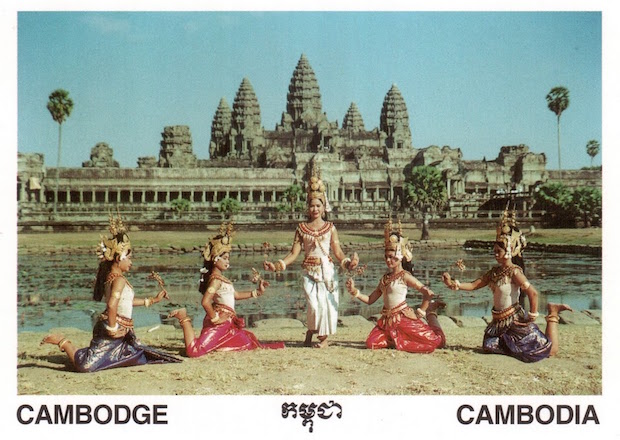
- Postcard from Cambodia – representing Apsara dancers. All rights reserved.
For this fifth session of the seminar The Apsara Transdisciplinary Research Club, dancers from Le Ballet Classique Khmer (BCK) association will initiate the participants to the complexity and diversity of the Apsara dance gestures.
The association Le Ballet Classique Khmer (BCK), or ‘Classical Khmer Ballet’ of Paris aims at preserving, transmitting, and making the millennial art of classical Cambodian dance known.
Funded in 1976 by SAR, the Princess Vacheahra Norodom and by dancers from the Royal Ballet from Phnom Penh, the association, thanks to the many performances made across France and the world, participated in the recognition of this art, which has been registered as part of the global immaterial heritage by the UNESCO. The teaching of the dance is provided by masters of renown, on a weekly basis.
The ballet is composed of Cambodian, French with Cambodian origins or French men and women of all ages. Several children of the first generation of Cambodian refugees who sought shelter in France found, through this association, a way to connect with their cultural roots.
Saturday October 22, at 3 p.m.
Conversation: Theatre of Movements in South-East Asia
With Vera Mey, Robert Vifian, Vuth Lyno.

- Masks from face casting workshop by SA SA ART PROJECTS’ artist-in-residence Tes Vannorng – with students at the White Building, 2016. All rights reserved.
This round table proposes, by using different scales (personal, national or transnational), to present three entities solely through the observation of their movements and interactions. The artist Vuth Lyno will present the project “Theatre of movements” which took place in the artists-run space Sa Sa Art Projects located in Phnom Penh, Cambodia, in August 2016, in collaboration with Bétonsalon – Center for Art and Research. Then, Vera Mey will extend the discussion and propose a cartography of different spaces of interactions and exchanges between artists in South-East Asia. Lastly, Robert Vifian will evoke the constitution of his collection and the links it nurtures with his own life and his personal and intimate movements.
Vera Mey (Born in 1987 in Wellington, New Zealand) is an independent curator based in London. She was part of the founding team of the NTU Centre for Contemporary Art Singapore led by Ute Meta Bauer from 2013. For 2015-2016 she is guest curator at Sa Sa Bassac and Bétobsalon –Center for Art adn Research, grantee of SOAS, University of London and Getty Foundation as part of Ambitious Alignments: New Histories of Southeast Asian Art.
Vuth Lyno (b. 1982, Phnom Penh) is an artist, curator and artistic director of Sa Sa Art Projects, Phnom Penh’s only artist-run space, located in the historic and presently endangered neighborhood known as the White Building. Vuth’s practice is primarily participatory and collaborative in nature, engaging specific Cambodian communities and the cultures unique to them. Vuth holds a Master of Art History from the State University of New York, Binghamton, supported by Fulbright fellowship.
Vuth is an artist-in-residence at the Cité internationale des arts through the “Traverses” program created with Bétonsalon - Center for Art and Research, Paris (2016) and was a participant of International Art Residency, Para Site, Hong Kong (2015).
Robert Vifian, born at Saigon (Vietnam) in 1948, is principally, and professionally, a chef and a sommelier. He started to collect contemporary art pieces in 1979. His collection has the specificity to be constituted solely of artworks made by young artists who have just begun their career. Robert Vifian has been curator of the retrospective exhibition of David Altmejd which took place at the ARC Flux from the Museum of Modern Art of the City of Paris (October 2004 – February 2005). The exhibition « Anywhere But Here » currently displays his portrait, conceived by Felix González-Torres in 1993.
Domaine Morère’s coffee tasting thanks to Pierre Morère’s generous donation. The Domaine Morère coffee is produced in Dalat (Vietnam).
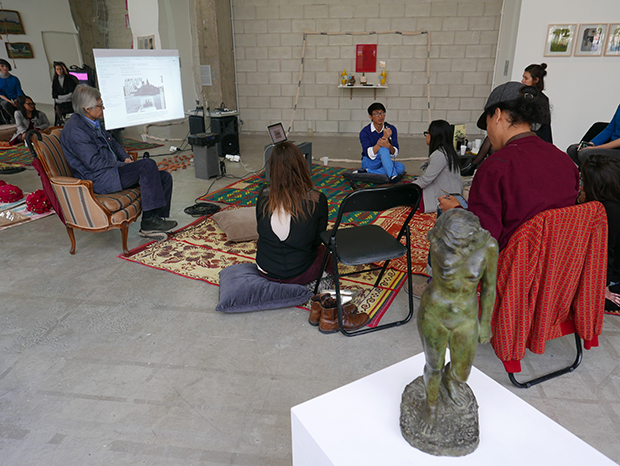
- Conversation: Theatre of Movements in South-East Asia – with Vera Mey, Robert Vifian, Vuth Lyno, in the framework of Anywhere But Here, Bétonsalon - Center for Art and Research, Paris, 2016.

- Conversation: Theatre of Movements in South-East Asia – with Vera Mey, Robert Vifian, Vuth Lyno, in the framework of Anywhere But Here, Bétonsalon - Center for Art and Research, Paris, 2016.
Tuesday October 25, 2016 from 6pm to 9pm - room number 8509, 5th floor
Vuth Lyno’s open-studio at the Cité internationale des arts (Marais) in the framework of Traverses.
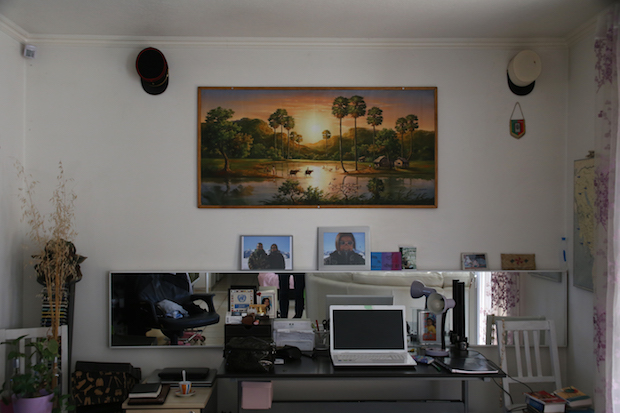
- Image of documentation of ’Keeping Peace’ – a project led by Vuth Lyno. Courtesy of the artist, all rights reserved.
For his open-studio, Vuth Lyno will present his ongoing project, Keeping Peace, which explores the implementation and consequences of the United Nations’ operations for maintaining peace in Cambodia. By combining personal and national tales that contributed to the writing of this moment of history, the artist aims at shedding light on the tensions and contradictions which are inherent to these years driven simultaneously by violence and by a deep aspiration to peace.
Vuth Lyno (b. 1982, Phnom Penh) is an artist, curator and artistic director of Sa Sa Art Projects, Phnom Penh’s only artist-run space, located in the historic and presently endangered neighborhood known as the White Building. Vuth’s practice is primarily participatory and collaborative in nature, engaging specific Cambodian communities and the cultures unique to them. Vuth holds a Master of Art History from the State University of New York, Binghamton, supported by Fulbright fellowship.
Vuth is an artist-in-residence at the Cité internationale des arts through the “Traverses” program created with Bétonsalon - Center for Art and Research, Paris (2016) and was a participant of International Art Residency, Para Site, Hong Kong (2015).
Wednesday October 26, from 6 p.m. to 8 p.m.
Seminar: The Apsara Transdisciplinary Research Club, session 6
A event in the framework of the Académie vivante
With Michael Falser, historian of architecture at the Heidelberg University : "Reenacting the Royal Khmer Ballet : 1890-2015"

- Edge of the pit of the temples of Angkor Vat in the region of Siem Reap – © Les Archives de la Planète, autochrome 1918-1921.
It is a commonplace that cultural heritage is not only a highly contested concept of
modern times, full of nationalistic undertones, cultural stereotypes and essentialist
topoi such as past grandeur and enduring cultural purity. Cultural heritage has also
become the easiest and most profitable prey for today’s global tourism industry. These
observations apply with particularly dramatic consequences to young emerging,
postcolonial nation states with a rich repertoire of built (tangible) and performed
(intangible) culture – especially if elements of this repertoire are branded ‘UNESCO
World Heritage’ without considering their contested formation histories. Few other iconic
heritage sites are more instructive in showcasing these observations than the temple
site of Angkor, by charting the transcultural trajectories of Cambodia’s heritage
construction through the processes of French colonial reinvention, postcolonial/nationalist
essentialisation, and global commodification. This presentation focuses on the ‘Royal
Khmer Ballet’ as cultural performance and heritage re-enactment in combination with
the twelfth-century temple of Angkor Wat as architectural stage.
Michael Falser is an Austrian architect and art historian. Currently he his project leader at the Chair of Global Art History within the Cluster of Excellence "Asia and Europe in a Global Context. The Dynamics of Transculturality" at Heidelberg University. With his long-standing research in the transcultural heritage formation of Angkor between the French-colonial period, independent Cambodia and today’s UNESCO World Heritage regime, he published on the art and architectural history and cultural heritage formations in a global context. His monograph Angkor Wat. From Jungle Find to Global Icon. A Transcultural History of Heritage will be published with DeGruyter in 2017.
Saturday October 29, at 3 p.m.
Conversation: patrimonial movements between archeological discourses and ritualisation.
With Michael Falser, historian of architecture at the Heidelberg University, and Maurizio Peleggi, history teacher at the National University of Singapore.

- The atelier de Moulage in the Musée Sarraut (today National Museum) in Phnom Penh – Cambodia in the 1920s. Source: National Museum of Phnom Penh, Cambodia.
This roundtable proposes to put into perspective the researches conducted by Michael Falser (architecture historian at the University of Heidelberg) and by Maurizio Peleggi (professor of history at the National University of Singapore) which both question some of the patrimonialisation processes in the light of the contemporary issues of restitution and reappropriation that concerned many of the museal institutions across the world.
The analysis of hidden power constellations in any translation process between cultures–in this special case between Asia and Europe–is an emerging feature in (trans-)cultural studies. However, with a strong focus on texts and images, techniques of direct material translation–such as plaster casts–are rarely discussed. And even if the cultural-historical value of this form of physical copying in European museum collections was rediscovered in the last decade, the analysis of their relevance in colonial translation politics has yet to be assessed.
This presentation focuses on the cultural-political history of French plaster casts. It is particularly interested in those made of the Cambodian temple of Angkor Wat during early French explorative missions, museum displays, and universal/colonial exhibitions (from the 1860s to 1930s). It explores the hypothesis that plaster casts were a powerful ‘translation tool’ to appropriate local, built heritage in the Indochinese colonies for global representation.
Michael Falser is an Austrian architect and art historian. Currently he his project leader at the Chair of Global Art History within the Cluster of Excellence "Asia and Europe in a Global Context. The Dynamics of Transculturality" at Heidelberg University. With his long-standing research in the transcultural heritage formation of Angkor between the French-colonial period, independent Cambodia and today’s UNESCO World Heritage regime, he published on the art and architectural history and cultural heritage formations in a global context. His monograph Angkor Wat. From Jungle Find to Global Icon. A Transcultural History of Heritage will be published with DeGruyter in 2017.
The journeys of the itinerant Buddha images
The Buddha images that were venerated as palladia in the Tai regional kingdoms established in present-day Laos and northern Thailand were highly mobile. Their peregrinations, both imaginary and factual, retraced the Buddha’s own legendary wanderings in the middle and upper Mekong region. Itinerant images were also believed to avail themselves, like film stars, of body doubles that undertook on their behalf the travails of travel. Their perilous journeys—involving seizures, kidnappings, and narrow escapes from shipwrecks, wars, and natural disasters—furnished also perfect narrative material for a literary genre that flourished in the kingdoms of Lanchang and Chiangmai in the XV and XVI th centuries. This talk retraces the journeys of these itinerant images and discusses their enduring place in religious devotion and cultural memory.
Maurizio Peleggi teaches in the department of history of the National University of Singapore since 1998. He is the author of several articles and books on the art and cultural history of Thailand, including The Politics of Ruins (2002), Lords of Things (2002), Thailand the Worldly Kingdom (2007), and, as editor, A Sarong for Clio (2015). His new book, Monastery, Monument, Museum: Sites and Artifacts of Cultural Memory in Thailand, is to be published in 2017.
Wednesday November 2, at 6 p.m. at the amphitheater Buffon (Paris Diderot University)
Le Sommeil d’Or (The Golden Sleep), a documentary by Davy Chou
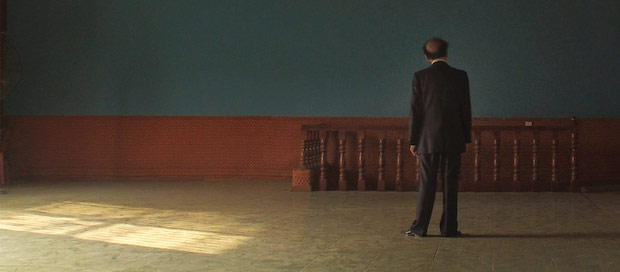
- Davy Chou – Le Sommeil d’Or or The Golden Sleep, 2012. All rights reserved.
Born in 1960, the ascension of Cambodian cinema has been stopped when the Khmers Rouges came into power in 1975. Most of films were destroyed, actors were killed, and the cinemas were closed, to later be transformed into restaurants or karaoke clubs. Le Sommeil d’Or (or The Golden Sleep) gives the floor back to some of the witnesses who have survived these troubled times, so as to revive spirit of this golden age of Cambodian films.
The projections of the CinéDiderot programmation are free of charge and open to everyone on reservation.
Saturday November 5, from 3 p.m. to 6 p.m.
Seminar: The Apsara Transdisciplinary Research Club, session 7
A event in the framework of the Académie vivante
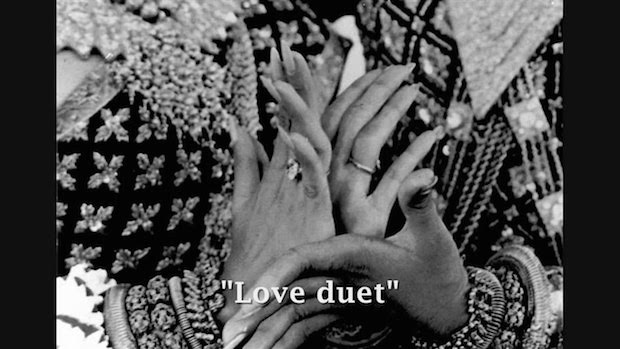
- "Love Duet" – all rights reserved.
For this concluding session of the seminar “The Apsara Transdisciplinary research Club”, we will receive Julie Burbage, clinical psychologist, who will address the theme of the dance, or rather of body in motions as a support for therapeutical practices. Dancers from the Ballet Classique Khmer (BCK association will join her so as to initiate the participants to the complex and diverse gestures of the Apsara dance.
From one body to another. Danced movement, or an occasion of transformation.
In this presentation, we will work with the observations resulting from a workshop implemented in a service for adult psychiatry, and particularly addressing psychotic patients. Then we will initiate a reflection on the ways danced movements can either provide an opportunity to create a new relation to the body for certain patients, or, for others, it can allow them to draw their own corporal outlines when those are hardly draft through experimenting with sensations. The psychoanalytical approach to the body will allow us to enlighten some of the sensorial et psychic issues which are at core of these transformations.
Julie Burbarge is a clinical psychologist at the Nursing Home of Epinay and at the accommodation and social rehabilitation center of the Poterne des Peupliers.
Holder of a jazz dance choreography certificate, she frequently offers therapeutical workshops based on danced movements.
Currently pursuing a PhD at the Paris VII University, her research focuses on the implication of somatism upon delirium within the frame of psychosis.
The association Le Ballet Classique Khmer (BCK), or ‘Classical Khmer Ballet’ of Paris aims at preserving, transmitting, and making the millennial art of classical Cambodian dance known.
Funded in 1976 by SAR, the Princess Vacheahra Norodom and by dancers from the Royal Ballet from Phnom Penh, the association, thanks to the many performances made across France and the world, participated in the recognition of this art, which has been registered as part of the global immaterial heritage by the UNESCO. The teaching of the dance is provided by masters of renown, on a weekly basis.
The ballet is composed of Cambodian, French with Cambodian origins or French men and women of all ages. Several children of the first generation of Cambodian refugees who sought shelter in France found, through this association, a way to connect with their cultural roots.
Share